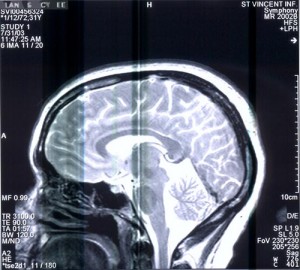 Every year in the United States, over one million people suffer a traumatic brain injury. The injured person can undergo serious long-term health problems including emotional, mental, and physical injuries. Many of those with brain injuries will develop seizures. About 25 percent of closed head injuries and 50 percent of penetrating, or open head injuries, will result in epilepsy.[1]
Every year in the United States, over one million people suffer a traumatic brain injury. The injured person can undergo serious long-term health problems including emotional, mental, and physical injuries. Many of those with brain injuries will develop seizures. About 25 percent of closed head injuries and 50 percent of penetrating, or open head injuries, will result in epilepsy.[1]
Epileptic seizures can cause serious neurological symptoms, such as severe paralysis or mental impairment. Behavioral changes and post-traumatic stress disorder are also common symptoms in those with head injuries and epilepsy.
The two types of traumatic brain injury are closed head injury and open head injury. If someone experiences a closed head injury, the wound may not appear major. It can be caused by a blow, sharp jerk, or bump. In an open head injury, there is severe penetrating trauma to the brain. When the brain is injured, its electrical functions in brain waves and nerve pathways become damaged, causing seizures.
About Epilepsy
Epilepsy is more likely to begin after an open head injury, but it may follow a closed head injury as well. It is important to understand that epileptic seizures may not arise until well after the head injury. Seizures may start months or even years after the head injury.
In most cases, symptoms start as early as 24 hours after the injury, but there may be a long time where the patient sees no signs or symptoms. The diagnosis of epilepsy from traumatic brain injury can be difficult in such cases.
Risk of Epilepsy
Current research is focused on finding the level of risk for developing epilepsy when compared to the time that has passed since the brain injury. A patient has a high risk of experiencing seizures immediately or shortly thereafter the injury. How long the risk lasts is unknown.
The risk of epilepsy may increase after both mild and severe brain injuries. It is difficult to say just how long the risk will last. The danger may increase with age, and there may be a higher risk for women with head injuries than men with similar wounds. Genetics complicate these questions even further. Those with a family history of epilepsy may be at a greater risk for developing the disease after a traumatic brain injury.
While antiepileptic drugs help to control seizures, they do cannot prevent future seizures entirely. There is no cure for epilepsy, so some patients must take seizure medications for the remainder of their lives.
Contact Us
If you or someone you know suffers from epilepsy because of a traumatic brain injury, contact our office. Our knowledgeable, experienced attorneys will provide you with a free consultation.
A financial settlement can help with your current and future medical bills, pain and suffering, and even lost wages or other damages. There’s no need to suffer alone with your head injury and epilepsy. Contact our office today for your free consultation.
[1] http://www.epilepsyfoundation.org/epilepsyusa/tbi-special-report.cfm



Subject: head injury and status epilepticus. Check out this theory: Injury to nerve tissue causes muscle spasms. Muscle spasms deplete GABA (Gamma Aminobutyric Acid). When the GABA is used up faster than it is created by the body, the brain crashes (seizures). Pull up an MRI image with at least 3 tesla. Look at the slices. If you see white brite spots, lesions, they are likely newer. I need help locating the interior bone spikes to correlate with possible contracoup contusion showing as a white lesion. ( But I know that waves showing up around the lesion could indicate TBI depending on the plaque.) I wonder if the MRI has a GPS type location set of numbers in 3D for the lesions and bony spikes inside the skull ?. In other words, how do you match the bony spike to the location of the lesion. And finally, how do you estimate the age of the lesion within a 6 month time frame ? Another way you get seizures from a head injury: Glutamates are produced enmasse for a solid 9-10 days after you get whacked on the head. They force positive ions into neurons, depolarizing the cell from it’s regular negative state to a positive state. This can cause an electrical storm(seizure). Pain also causes glutamates. Most doctors don’t even understand this, let alone testify in a court. They just write up prescriptions . If you are a victim, remember that glutamine is a precursor and is converted into GABA. And taurine is a precursor for many inhibitory neurotransmitters as well as closely mimics GABA at the GABA receptor sites. (Drug companies call these BENZO sites, referring to their drugs such as Ativan and Valium and others. Those are benzo drugs, your ticket to the Twilight Zone ) When the GABA runs out, the seizure occurs. In the ER, they induce a coma into status epilepticus victims using the benzo drugs and tie the victim to the rails overnight. Billie Sahley PHD wrote a good book on GABA, the anxiety amino acid. She in in San Antonio TX. and runs a painstress center. Google Scholar has hundreds of studies on this subject.